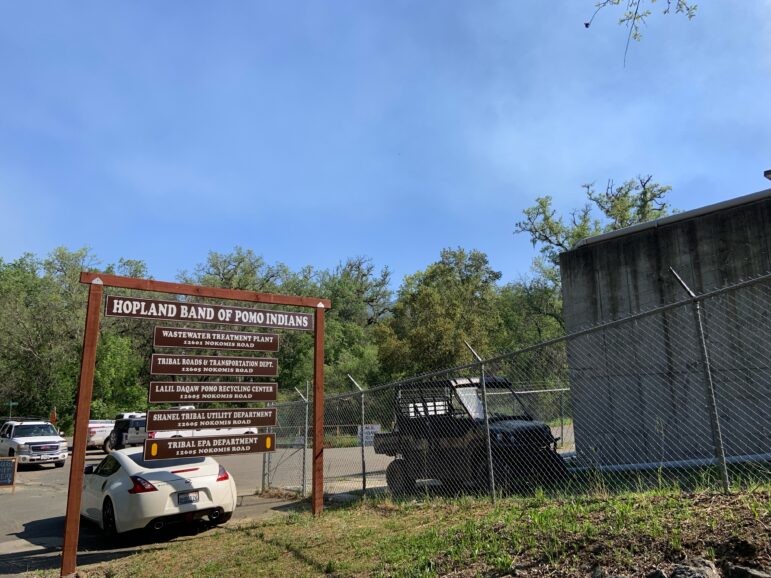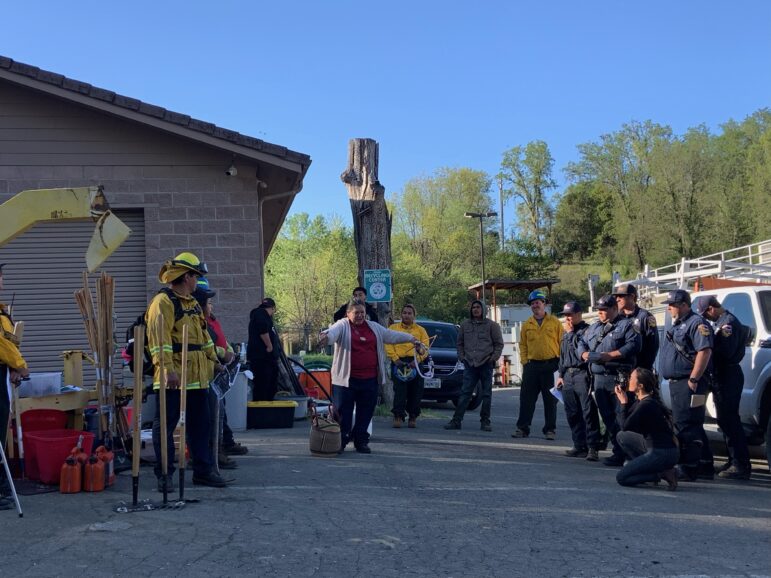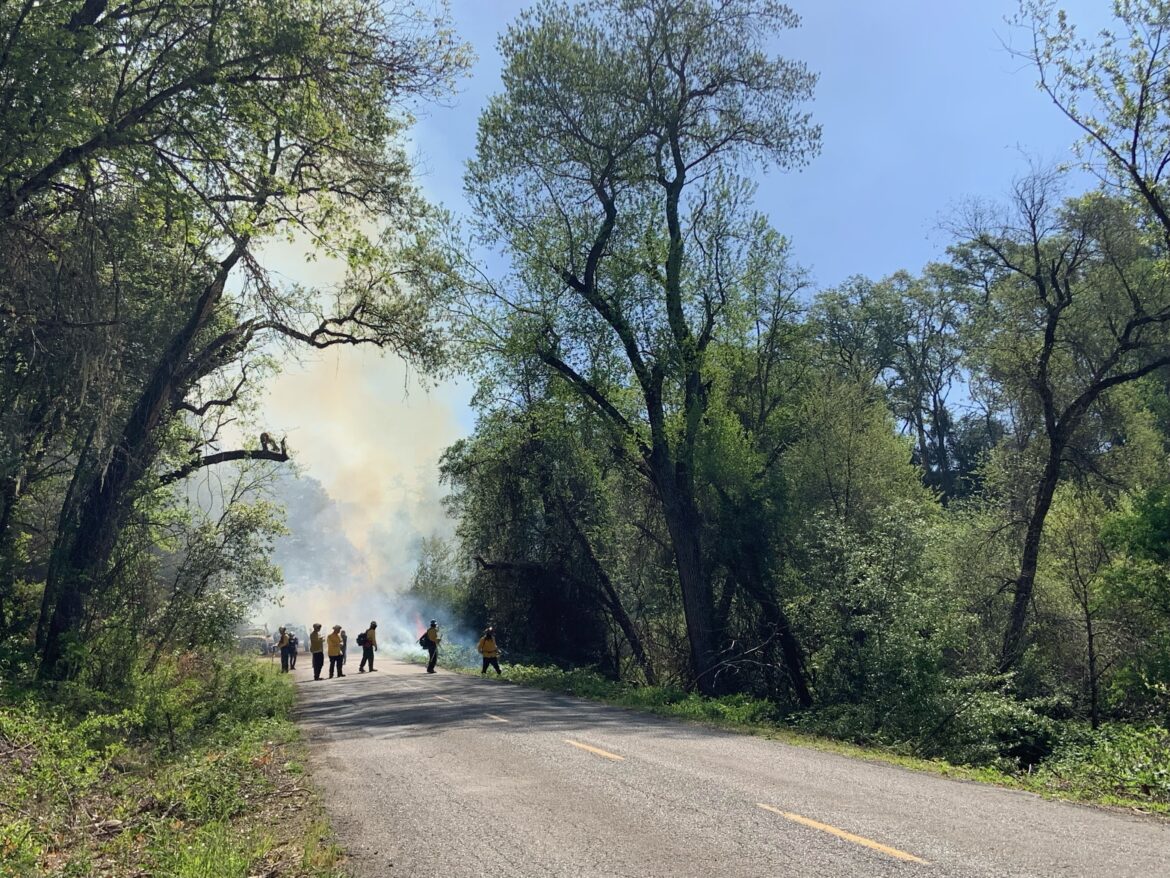HOPLAND, CA, 5/4/23 — Months before dozens of people from the Hopland Band of Pomo Indians, the Tribal EcoRestoration Alliance (TERA), Cal Fire Mendocino Unit, Mendocino Prescribed Burn Association, and more agencies gathered for a cultural burn on the lands of the Hopland Band of Pomo Indians on a Friday morning, Derek Abella’s team combed the entire area diligently removing dead trees and marking plant species significant to tribal lifeways for burners to mind.
Abella works for the Hopland Band of Pomo Indians’ Environmental Protection Agency (EPA), where he’s also been focused this spring on cutting grass and clearing defensible space around elders’ homes for fire protection. He worries about the rancheria’s susceptibility to terrifying wildfires, with good reason.
“When there was a fire in 2017, the fire came over the hill and we didn’t have any resources or anybody that knew what to do,” he told The Mendocino Voice. “So we evacuated, but because we have a farmer up there that owns land, he got into his tractor and he did a burn line. It was a good thing for that … Right then, that opened my eyes saying, ‘Hey, we need to get something here.’ We found out TERA was doing their thing, so [Hopland] sent a handful of us over there to learn how to do it. I’m so grateful that they finally came here. This is just the beginning of what we need to get going here.”
After being trained with TERA last year himself, Abella hopes that the training for Hopland tribal members earlier in the week — coordinated by Thea Partida, also of the EPA — will help the tribe work on future “good fire” projects, to mitigate wildfire impacts and promote healthy ecosystems on the land. As TERA Board Chair TeMashio Anderson told The Voice in a conversation last year, colonizers suppressed burning that indigenous tribes had long practiced in California.
“The way the land was managed when fire was taken away, through the establishment of the US Forest Service and their belief that suppression was the best form of fire management, was basically a lack of understanding of fire ecology in our dominant society,” he said.

This impact has played out differently across the diverse landscapes of the North Coast, but prescribed burning is coming back into fashion for state and federal agencies as a route to mitigate progressively hotter, larger, and more deadly wildfires. TERA is in the business of cultural burning, which emphasizes ecological sensitivity and also works to preserve and enhance habitat for significant species to tribes.
“Our mission is to heal the land through stewardship work and to help build capacity in our communities,” TERA Crew Lead Stoney Timmons said at Friday’s burn.
This burn’s goal was heavily reducing over-seeded Himalayan blackberry, which deteriorates soil health and has a detrimental impact on the growth of other species like willow and dogwood in Hopland’s riparian zone.
To demonstrate the importance of those other tree species, Patricia Ray Franklin gave a demonstration on Pomo basket-weaving practices, displaying a variety of different baskets for carrying or to be used as cradles. She is part of the Pomo Weaver’s Society, a group that formed during the COVID-19 pandemic to preserve Pomo traditional techniques. Weavers make baskets using native species including the bark and dyes from willow, elderberry, and dogwood trees found in the burn zone.
“If you’re a basket weaver, you have to get connected to the plants,” she said. “You have to get connected to the land. That’s so important — it’s kind of a circle, because without that we’re not going to continue our culture.”

Before burning, Hopland Band of Pomo Indians Chair Sonny Elliott opened the day with a similar message. He reminded those gathered that while it’s been more than 100 years since indigenous people could put down fire on these lands, in the grand scheme of things that’s not a long time.
“The land here has evolved over millennia with fires throughout the year, throughout the course of time,” he told the crowd. “Then that was stripped, which I relate to in a lot of ways — our culture, our traditions and those things were stripped from our people. We have to get back to balance. … What you see is the risk of wildfire because that fire hasn’t been on the ground. … Naturally, there’s a cycle, and hopefully we’re able to implement that cycle back in again and be a part of that.”
TERA recently held a Fire, Forestry, and Land Stewardship Career Fair. The organization is also continuing to expand its work from Lake County into Mendocino County, and continues to actively seek tribes with whom to collaborate.
“Thanks y’all, for just continuing to show up and put in the hard work and be part of the team,” said TERA Executive Director Lindsay Dailey on Friday. “It’s awesome to see this grow.”
Note: Kate Fishman covers the environment & natural resources for The Mendocino Voice in partnership with a Report For America. Her position is funded by the Community Foundation of Mendocino, Report for America, & our readers. You can support Fishman’s work with a tax-deductible donation here or by emailing [email protected]. Contact her at KFishman@mendovoice.com or at (707) 234-7735. The Voice maintains editorial control and independence.





